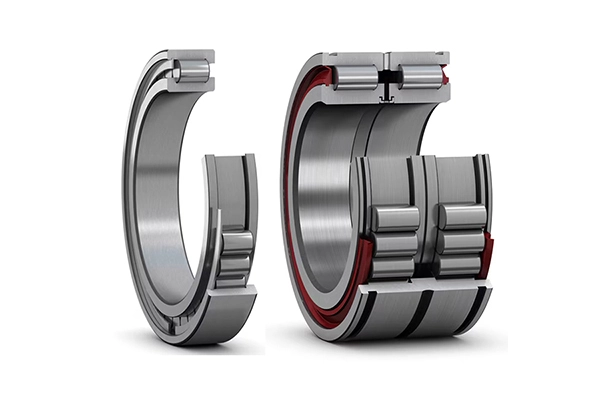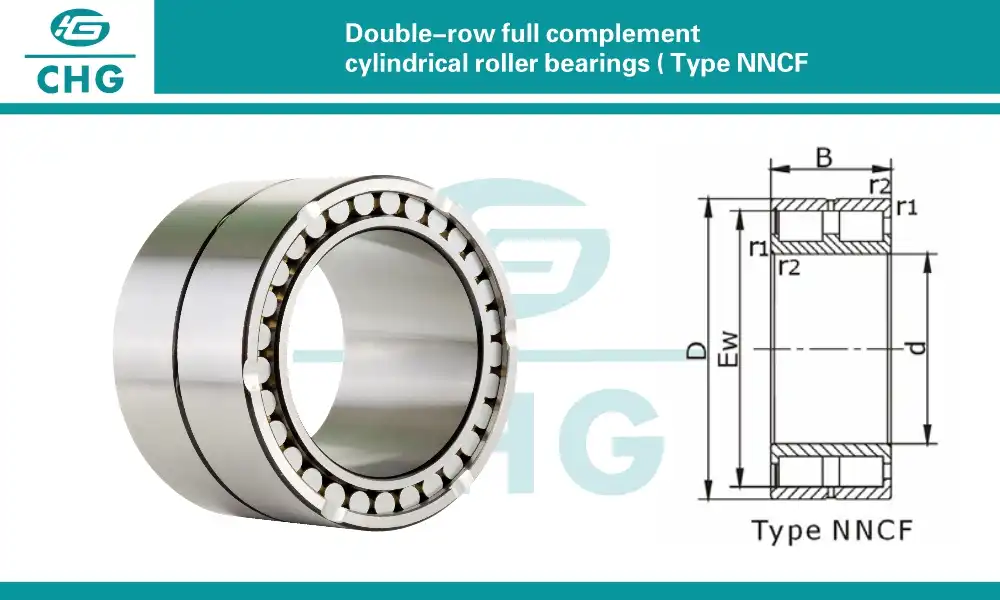Are Full Complement Cylindrical Roller Bearings Suitable for High-Speed Applications?
When it comes to selecting bearings for high-speed applications, engineers often face the challenge of balancing load capacity, durability, and operational efficiency. Full complement cylindrical roller bearings, characterized by their design without a cage and maximum number of rollers, are renowned for their exceptional load-carrying capacity, making them a popular choice in heavy-duty applications. However, their suitability for high-speed environments, such as those found in automotive transmissions, aerospace systems, or high-speed machinery, is a critical question. Full complement cylindrical roller bearings are designed to handle significant radial loads, but their performance at high speeds depends on various factors, including design modifications, lubrication, and operating conditions. This blog explores the potential of full complement cylindrical roller bearings in high-speed applications, highlighting their advantages and the considerations that ensure optimal performance.

How Do Full Complement Cylindrical Roller Bearings Perform Under High-Speed Conditions?
Load Capacity Advantages of Full Complement Cylindrical Roller Bearings
Full complement cylindrical roller bearings are engineered to maximize load capacity by incorporating the greatest possible number of rollers without a cage, allowing them to handle substantial radial loads. This design is particularly advantageous in applications where high load capacity is a priority, such as in heavy machinery or industrial gearboxes. However, in high-speed conditions, the absence of a cage can pose challenges, as it may lead to increased roller-to-roller contact and friction. Despite this, full complement cylindrical roller bearings can still perform effectively at high speeds when designed with precision and paired with appropriate lubrication systems. For instance, in automotive applications like high-speed differentials, these bearings can support heavy loads while maintaining stability, provided that operating conditions are carefully managed. Their ability to handle high loads makes full complement cylindrical roller bearings a valuable option in demanding environments.
Friction and Heat Management in Full Complement Cylindrical Roller Bearings
One of the key considerations for the performance of full complement cylindrical roller bearings in high-speed applications is the management of friction and heat. Without a cage, the rollers are in direct contact with one another, which can increase friction and generate heat, potentially affecting efficiency and longevity at high speeds. However, advancements in bearing design and lubrication technology have mitigated these challenges, making full complement cylindrical roller bearings suitable for high-speed use in certain scenarios. For example, in aerospace applications, such as turbine engines, specialized lubricants and cooling systems can be employed to reduce friction and dissipate heat effectively. Additionally, precision manufacturing ensures that the rollers are uniformly sized and spaced, minimizing contact stresses. These measures enable full complement cylindrical roller bearings to operate efficiently at high speeds, ensuring reliable performance in critical applications.

Design Modifications for Full Complement Cylindrical Roller Bearings
To enhance the suitability of full complement cylindrical roller bearings for high-speed applications, specific design modifications can be implemented. While the absence of a cage maximizes load capacity, it can be a limiting factor at high speeds due to increased roller contact. To address this, manufacturers can optimize the roller geometry and surface finish to reduce friction and improve rolling efficiency. Additionally, full complement cylindrical roller bearings can be designed with advanced materials, such as ceramics or high-strength alloys, to withstand the stresses of high-speed operation. For instance, in high-speed industrial machinery, such as compressors, these bearings can be tailored with enhanced surface treatments to minimize wear and heat generation. These design modifications ensure that full complement cylindrical roller bearings can meet the demands of high-speed applications, providing a balance of load capacity and operational efficiency.
What Are the Key Benefits of Using Full Complement Cylindrical Roller Bearings in High-Speed Applications?
Enhanced Load Distribution in Full Complement Cylindrical Roller Bearings
One of the primary benefits of full complement cylindrical roller bearings in high-speed applications is their ability to provide enhanced load distribution. The maximum number of rollers ensures a larger contact area between the rollers and raceways, allowing for even distribution of radial loads. This feature is particularly valuable in high-speed environments, where uneven load distribution can lead to instability and wear. For example, in automotive applications like high-speed wheel hubs, full complement cylindrical roller bearings can support heavy radial loads while maintaining stability at elevated speeds. The even load distribution reduces stress concentrations, enhancing the durability and reliability of the bearings. This advantage makes full complement cylindrical roller bearings a preferred choice in applications where both high load capacity and high-speed performance are required, ensuring consistent operation under demanding conditions.

Durability and Longevity of Full Complement Cylindrical Roller Bearings
Full complement cylindrical roller bearings are renowned for their durability and longevity, even in high-speed applications, when properly designed and maintained. The absence of a cage allows for a greater number of rollers, which increases the bearing’s ability to withstand heavy loads without compromising structural integrity. This durability is critical in high-speed environments, where components are subjected to continuous stress and potential wear. For instance, in industrial applications like high-speed conveyor systems, full complement cylindrical roller bearings can operate reliably over extended periods, thanks to their robust construction and advanced materials. Additionally, the use of high-quality lubricants and precision manufacturing further enhances their longevity by reducing friction and wear. These factors ensure that full complement cylindrical roller bearings deliver long-lasting performance, making them a cost-effective solution for high-speed applications.
Versatility Across High-Speed Industries with Full Complement Cylindrical Roller Bearings
The versatility of full complement cylindrical roller bearings is another key benefit, as they can be adapted to meet the needs of various high-speed industries, including automotive, aerospace, and industrial machinery. Their ability to handle high radial loads while operating at elevated speeds makes them suitable for a wide range of applications, from high-speed gearboxes in vehicles to turbine engines in aircraft. For example, in the energy sector, full complement cylindrical roller bearings can be used in high-speed wind turbine generators, where they support heavy loads while maintaining efficiency. Their adaptability is further enhanced by the ability to customize features such as roller geometry, materials, and lubrication systems to suit specific operating conditions. This versatility ensures that full complement cylindrical roller bearings can meet the diverse demands of high-speed applications, providing reliable and efficient performance across industries.
How Can Full Complement Cylindrical Roller Bearings Be Optimized for High-Speed Performance?
Lubrication Strategies for Full Complement Cylindrical Roller Bearings
Lubrication plays a crucial role in optimizing the performance of full complement cylindrical roller bearings in high-speed applications. Effective lubrication reduces friction, dissipates heat, and prevents wear, ensuring smooth operation at elevated speeds. Given the increased roller-to-roller contact in these bearings, selecting the right lubricant is essential. For high-speed applications, such as automotive transmissions, oil lubrication is often preferred due to its ability to flow and cool the bearing effectively. In contrast, grease lubrication may be used in applications where sealing is a priority, such as in industrial machinery. Additionally, advanced synthetic lubricants with high thermal stability can be employed to enhance performance in extreme conditions. By implementing proper lubrication strategies, full complement cylindrical roller bearings can achieve optimal efficiency and reliability, making them suitable for high-speed environments.
Precision Manufacturing of Full Complement Cylindrical Roller Bearings
Precision manufacturing is another critical factor in optimizing full complement cylindrical roller bearings for high-speed performance. High-precision production techniques, such as grinding and honing, ensure that the rollers, raceways, and other components are manufactured with tight tolerances, minimizing vibration and ensuring smooth operation. This precision is particularly important in high-speed applications, where even minor deviations can lead to instability and wear. For example, in aerospace applications like jet engine turbines, full complement cylindrical roller bearings must be produced with exceptional accuracy to maintain performance at high rotational speeds. Additionally, advanced surface treatments, such as polishing or coating, can be applied to reduce friction and enhance durability. These precision manufacturing practices ensure that full complement cylindrical roller bearings deliver consistent performance, extended service life, and reliability in high-speed applications.
Cooling Systems for Full Complement Cylindrical Roller Bearings
The integration of cooling systems is an effective way to optimize full complement cylindrical roller bearings for high-speed performance, particularly in applications where heat generation is a concern. High speeds can lead to increased friction and heat, which, if not managed, can affect the efficiency and longevity of the bearings. To address this, cooling systems, such as oil circulation or air cooling, can be employed to dissipate heat and maintain optimal operating temperatures. For instance, in high-speed industrial machinery like compressors, full complement cylindrical roller bearings can be paired with oil cooling systems to ensure efficient heat removal. Similarly, in automotive applications, such as high-speed differentials, cooling channels can be integrated into the bearing housing to enhance performance. These cooling strategies ensure that full complement cylindrical roller bearings operate reliably at high speeds, providing a robust solution for demanding applications.
Conclusion
In conclusion, full complement cylindrical roller bearings can be suitable for high-speed applications when designed, lubricated, and maintained appropriately. Their exceptional load capacity, durability, and versatility make them valuable in industries requiring high-speed performance, provided that friction, heat, and other challenges are effectively managed. Through design modifications, precision manufacturing, and advanced lubrication and cooling strategies, full complement cylindrical roller bearings can deliver reliable and efficient performance in high-speed environments, making them a viable choice for demanding applications.

Luoyang Huigong Bearing Technology Co., Ltd. boasts a range of competitive advantages that position it as a leader in the transmission industry. Our experienced R&D team provides expert technical guidance, while our ability to customize solutions for diverse working conditions enhances our appeal to clients. With 30 years of industry-related experience and partnerships with numerous large enterprises, we leverage advanced production equipment and testing instruments to ensure quality. Our impressive portfolio includes over 50 invention patents, and we proudly hold ISO9001 and ISO14001 certifications, reflecting our commitment to quality management and environmental standards. Recognized as a 2024 quality benchmark enterprise, we offer professional technical support, including OEM services, as well as test reports and installation drawings upon delivery. Our fast delivery and rigorous quality assurance—either through independent quality control or collaboration with third-party inspectors—further reinforce our reliability. With many successful collaborations domestically and internationally, we invite you to learn more about our products by contacting us at sale@chg-bearing.com or calling our hotline at +86-0379-65793878.
References
1. Harris, T. A., & Kotzalas, M. N. (2006). Rolling Bearing Analysis: Essential Concepts of Bearing Technology. CRC Press.
2. Brändlein, J., Eschmann, P., Hasbargen, L., & Weigand, K. (1999). Ball and Roller Bearings: Theory, Design, and Application. Wiley.
3. Shigley, J. E., & Mischke, C. R. (2001). Mechanical Engineering Design. McGraw-Hill.
4. Palmgren, A. (1959). Ball and Roller Bearing Engineering. SKF Industries.
5. Hamrock, B. J., Schmid, S. R., & Jacobson, B. O. (2004). Fundamentals of Machine Elements. McGraw-Hill.
6. Stachowiak, G. W., & Batchelor, A. W. (2013). Engineering Tribology. Butterworth-Heinemann.

